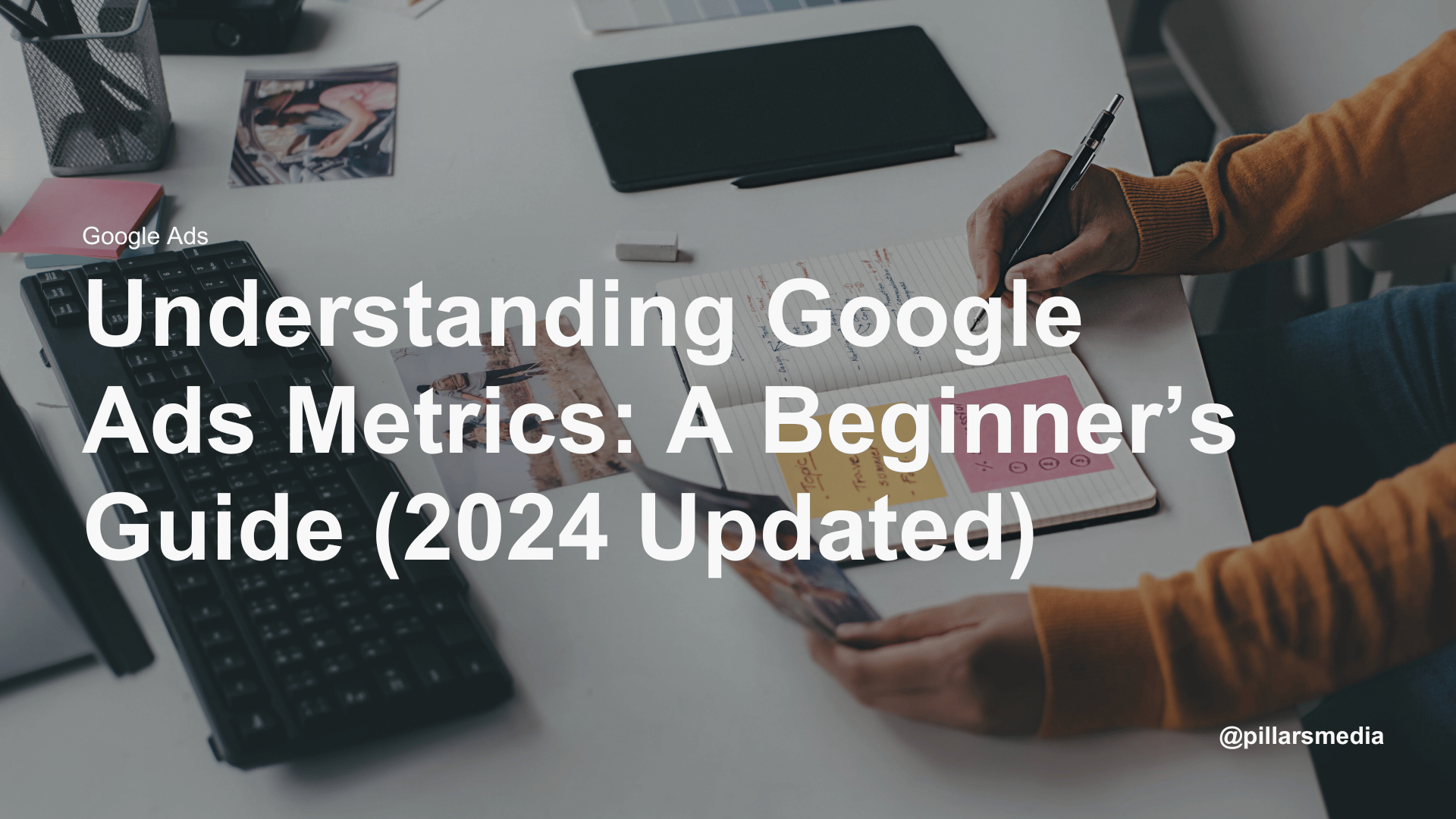List of important metrics in Google Ads you should know
- Impressions
- Clicks
- Click-through rate (CTR)
- Cost per click (CPC)
- Cost
- Conversions
- Conversion rate
- Average cost per conversion (CPA)
- Return on ad spend (ROAS)
- Quality score
- Ad rank
- Impression share
- Top of page rate
- Search lost IS (budget)
- Search lost IS (rank)
Google Ads offers an abundance of metrics that can easily lead to information overload, making it difficult to assess campaign performance effectively.
For beginners, this flood of data, each with its own set of definitions, can be particularly daunting.
In this blog, we’ll guide you through the key Google Ads metrics that matter most, helping you cut through the noise and make informed decisions about your ad campaign performance.
1. Impressions
Impressions refer to the number of times your ad is displayed, indicating its visibility to users. While a high number of impressions suggests that your ad is being shown frequently, it doesn’t necessarily translate into user engagement.
If you notice that impressions are high but clicks remain low, this could signal that your ad creative or targeting may need adjustments to better capture attention and encourage clicks. Analyzing the balance between impressions and clicks is crucial for optimizing your campaign’s effectiveness.
2. Clicks
Clicks represent the number of times users have interacted with your ad by clicking on it, making them a direct indicator of user interest. While a high click count suggests that your ad is attracting attention, it’s crucial to ensure these clicks are translating into meaningful actions, such as leads or sales.
Simply driving clicks isn’t enough—your ad and landing page must work together to convert this interest into tangible results. Regularly analyzing the relationship between clicks and conversions can help you refine your strategy to maximize ROI.
3. Click-through rate (CTR)
Click-through rate (CTR) is the ratio of clicks to impressions, calculated by dividing the number of clicks by the number of impressions. A high CTR is a strong indicator that your ad is resonating with your audience, showing that your messaging and targeting are on point. Conversely, a low CTR suggests that your ad might not be capturing attention or appealing to the right audience.
In such cases, it’s important to revisit your ad copy, creative elements, or targeting strategy to improve relevance and drive more engagement. Monitoring and optimizing CTR is essential for ensuring your ads are effective and aligned with user intent.
4. Cost per click (CPC)
Cost per click (CPC) refers to the average amount you pay each time someone clicks on your ad. While a lower CPC can be advantageous as it allows you to stretch your budget further, it’s crucial to balance cost with the quality of traffic you’re attracting. Cheaper clicks may not always result in valuable leads or conversions, so in some cases, investing in higher CPCs for better-targeted, higher-quality clicks can yield a better return on investment.
Ultimately, the goal is to optimize CPC in a way that maximizes both the quantity and quality of traffic, ensuring that you’re getting the most out of your advertising spend.
5. Cost
Cost refers to the total amount you’ve spent on your ads, a critical metric for managing your advertising budget and assessing the financial efficiency of your campaigns. Monitoring your total cost allows you to ensure that your spending aligns with your budgetary constraints while providing insight into whether your investment is delivering the desired results.
By regularly evaluating your total ad spend in relation to key performance indicators such as conversions and ROI, you can make informed decisions about adjusting your strategy to maximize the effectiveness and profitability of your campaigns.
6. Conversions
Conversions represent the number of times your ad leads to a desired action, such as a purchase or sign-up.
A high number of conversions typically signals that your ads are resonating well with your audience and that your targeting strategies are effective. Conversely, if conversions are low, it suggests that there may be issues with your ad copy, creative elements, or landing pages.
Analyzing these aspects can help identify areas for improvement, enabling you to refine your approach and enhance your campaign’s ability to drive valuable actions and achieve your marketing goals.
7. Conversion rate
Conversion rate is the percentage of clicks on your ad that lead to a desired action, calculated by dividing the number of conversions by the number of clicks. A high conversion rate indicates that your ad and landing page are effectively engaging users and driving them to take the intended action, reflecting the overall strength of your campaign’s messaging and user experience.
On the other hand, a low conversion rate suggests that there may be disconnects between your ad, its targeting, or the landing page, signaling an opportunity for optimization.
Improving this metric involves refining your ad content, enhancing the user journey on your landing page, and ensuring alignment with user intent to boost campaign performance.
8. Average cost per conversion (CPA)
Average cost per conversion (CPA) is the average amount you spend to acquire a single conversion, such as a purchase or sign-up. A lower CPA is generally desirable, as it reflects more efficient spending and a better return on your advertising investment. Conversely, a high CPA may indicate that your targeting needs refinement or that your landing page requires improvements to better convert visitors into customers.
By analyzing and optimizing your CPA, you can enhance the effectiveness of your ad campaigns and ensure that your budget is being used effectively to achieve your desired outcomes.
9. Return on ad spend (ROAS)
Return on ad spend (ROAS) measures the revenue generated for every dollar spent on advertising.
A higher ROAS indicates that your ads are effectively driving profitable revenue, making it a key metric for assessing the financial success of your campaigns. To optimize your advertising strategy, focus on maximizing ROAS by refining your targeting, improving your ad creative, and ensuring that your campaigns are aligned with your revenue goals.
By continually monitoring and enhancing this metric, you can ensure that your advertising investments are delivering strong financial returns.
10. Quality score
Quality Score is a metric provided by Google that evaluates the relevance and effectiveness of your ad, keywords, and landing page. A high Quality Score indicates that your ad and associated elements are closely aligned with user intent, which can lead to lower cost per click (CPC) and better ad placement.
To enhance your Quality Score, prioritize improving the relevance and quality of your ad copy, ensuring your keywords are closely related to your content, and optimizing your landing page to deliver a seamless and relevant user experience.
By focusing on these areas, you can boost your Quality Score, reduce costs, and achieve more effective ad performance.
11. Ad rank
Ad rank determines the position of your ad on the search results page and directly impacts its visibility to users. A higher ad rank results in better placement, increasing the likelihood that your ad will be seen and clicked. This ranking is influenced by both your bid amount and your Quality Score, which reflects the relevance and quality of your ad, keywords, and landing page.
To improve your ad rank, focus on enhancing your Quality Score through relevant and engaging ad content and optimizing your landing page, while also managing your bid strategy effectively.
By doing so, you can secure more prominent ad positions and drive better results from your campaigns.
12. Impression share
Impression share represents the percentage of total possible impressions that your ad actually received compared to the total number of impressions it could have achieved. A high impression share indicates that your ad is achieving strong visibility within your target audience. Conversely, a low impression share may signal that you need to increase your bids or improve the quality and relevance of your ads to capture more opportunities.
Monitoring and optimizing your impression share can help ensure that your ads are reaching the maximum potential audience and achieving the desired impact.
13. Top of page rate
Top of page rate measures the percentage of your ads that appear at the top of the search results page. A higher top-of-page rate indicates that your ads are achieving more prominent visibility, which can enhance their effectiveness and increase click-through rates.
To improve this metric, focus on optimizing your bid strategy and ad quality, ensuring that your ads are well-targeted and relevant to users’ search queries.
By enhancing your top-of-page rate, you can secure better ad placements, drive more engagement, and ultimately achieve better results from your campaigns.
14. Search lost IS (budget)
Search lost impression share (budget) represents the percentage of times your ads were not displayed due to an insufficient budget. This metric highlights how budget constraints are impacting your ad visibility and limiting your ability to capture potential impressions.
A high percentage suggests that your current budget may be too restrictive, preventing your ads from reaching their full potential audience.
To reduce lost impression share and improve your ad performance, consider increasing your budget or reallocating it more effectively to ensure your ads are shown more consistently and to a larger audience.
15. Search lost IS (rank)
Search lost impression share (rank) measures the percentage of times your ads were not shown because of a low Ad Rank. This metric indicates whether issues with your ad quality or bid amounts are impacting your ad visibility. A high percentage of lost impression share due to rank suggests that your ads may not be performing well in terms of relevance or competitiveness.
To address this, focus on enhancing your ad quality by improving your ad copy, keywords, and landing pages, and consider increasing your bids to boost your Ad Rank. By doing so, you can reduce lost impression share and ensure that your ads have better visibility and performance.
Conclusion
To sum it up, understanding key Google Ads metrics for performance analysis is crucial for any business looking to grow in today’s digital landscape.
Each metric offers valuable insights that can help you refine your strategy and improve your campaign performance.
If you’re looking for expert guidance, Pillars Media, a Google Ads agency in Malaysia, is here to help.

